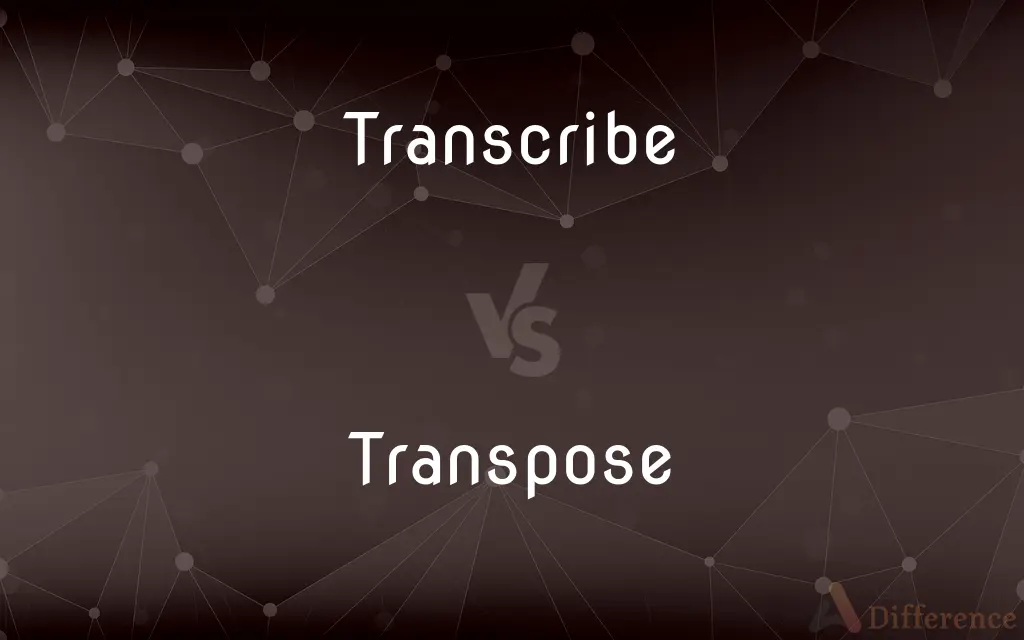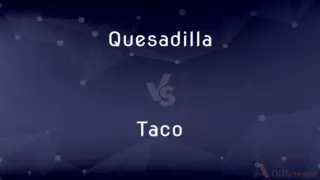Transcribe vs. Transpose — What's the Difference?
By Tayyaba Rehman & Fiza Rafique — Updated on April 5, 2024
Transcribing involves converting speech into written text, focusing on accuracy, while transposing shifts musical notes or data from one key or format to another, emphasizing adaptation.

Difference Between Transcribe and Transpose
Table of Contents
ADVERTISEMENT
Key Differences
Transcribing is the process of converting audio or spoken words into a written or textual format. It requires attention to detail and accuracy to ensure the spoken words are captured as precisely as possible. Transcribers may work with legal, medical, or media content, where fidelity to the original speech is paramount. On the other hand, transposing involves changing the key of a piece of music, moving data from one format to another, or adjusting the order of information. It's a critical skill in music for adapting compositions to suit different voices or instruments and in data management for reorganizing information.
In music, transposing is essential for musicians to play pieces in keys that are more suitable for their instruments or vocal ranges. This adjustment can make a piece more accessible or better sounding for a particular ensemble. Whereas in transcribing music, the aim is to write down the notes as they are played or sung, without changing their pitch or key, to create a faithful written representation of the music.
In the context of data and information, transcribing often refers to typing out handwritten notes, digitizing printed information, or creating subtitles for videos. The goal is to reproduce the original content accurately in a new format. Transposing, in this context, might involve changing the structure of a database, rearranging spreadsheet columns, or converting data types, to improve accessibility or analysis.
Technological tools have evolved to assist with both transcribing and transposing. Software can automatically transcribe audio to text or transpose music into different keys. However, human oversight is often necessary to ensure accuracy in transcription and to make artistic or contextual decisions in transposition.
The skills required for transcribing and transposing differ significantly. Transcribing demands a keen ear, fast typing skills, and familiarity with the subject matter to ensure precision. Transposing, especially in music, requires an understanding of theory and harmony to maintain the piece's integrity in a new key or arrangement.
ADVERTISEMENT
Comparison Chart
Definition
Converting speech into text or a written format.
Shifting musical notes or data to a different key or format.
Key Skills
Attention to detail, accuracy, typing speed.
Musical theory knowledge, data manipulation skills.
Primary Context
Legal, medical, media transcription; digitizing information.
Music adaptation; data and information reorganization.
Goal
Faithful reproduction of spoken words or original text.
Adapting content to suit different instruments, voices, or analysis needs.
Tools
Transcription software, foot pedals for playback control.
Music notation software, data management tools.
Compare with Definitions
Transcribe
Producing a written record of speeches.
Transcribing political speeches for publication.
Transpose
Changing music to a different key.
Transposing a song to match a singer's vocal range.
Transcribe
Digitizing handwritten notes.
Transcribing historical documents into digital archives.
Transpose
Rearranging spreadsheet columns.
Transposing columns for better data comparison.
Transcribe
Converting spoken words into text.
Transcribing an interview for a news article.
Transpose
Modifying data structure.
Transposing a database table to optimize data analysis.
Transcribe
Creating subtitles for videos.
Transcribing dialogue for movie subtitles.
Transpose
Converting information formats.
Transposing written information into graphical representations.
Transcribe
Typing out audio recordings.
Transcribing medical dictations for patient records.
Transpose
Adapting sheet music for another instrument.
Transposing clarinet music for a saxophone.
Transcribe
To make a full written or typewritten copy of (dictated material, for example).
Transpose
In linear algebra, the transpose of a matrix is an operator which flips a matrix over its diagonal; that is, it switches the row and column indices of the matrix A by producing another matrix, often denoted by AT (among other notations).The transpose of a matrix was introduced in 1858 by the British mathematician Arthur Cayley.
Transcribe
(Computers) To transfer (information) from one recording and storing system to another.
Transpose
To reverse or transfer the order or place of; interchange.
Transcribe
To adapt or arrange (a composition) for a voice or instrument other than the original.
Transpose
(Mathematics) To move (a term) from one side of an algebraic equation to the other side, reversing its sign to maintain equality.
Transcribe
To translate (a composition) from one notational system to another.
Transpose
(Music) To write or perform (a composition) in a key other than the original or given key.
Transcribe
To reduce (live or recorded music) to notation.
Transpose
To render into another language.
Transcribe
To record, usually on tape, for broadcast at a later date.
Transpose
To alter in form or nature; transform
A diary that was transposed into a novel.
Transcribe
(Linguistics) To represent (speech sounds) by phonetic symbols.
Transpose
(Music) To write or perform music in a different key.
Transcribe
To translate or transliterate.
Transpose
To admit of being transposed.
Transcribe
(Biology) To cause (DNA) to undergo transcription.
Transpose
A matrix formed by interchanging the rows and columns of a given matrix.
Transcribe
To convert a representation of language, typically speech but also sign language, etc., to a written representation of it. The term now usually implies the conversion of speech to text by a human transcriptionist with the assistance of a computer for word processing and sometimes also for speech recognition, the process of a computer interpreting speech and converting it to text.
Transpose
(transitive) To reverse or change the order of (two or more things); to swap or interchange.
Transcribe
(dictation) To make such a conversion from live or recorded speech to text.
The doctor made several recordings today which she will transcribe into medical reports tomorrow.
Transpose
To rewrite or perform (a piece) in another key.
Transcribe
(computing) To transfer data from one recording medium to another.
Transpose
To move (a term) from one side of an algebraic equation to the other, reversing the sign of the term.
Transcribe
(music) To adapt a composition for a voice or instrument other than the original; to notate live or recorded music.
Transpose
To rearrange elements in a matrix, by interchanging their respective row and column positional indicators.
Transcribe
(biochemistry) To cause DNA to undergo transcription.
Transpose
To give force to a directive by passing appropriate implementation measures.
Transcribe
(linguistics) To represent speech by phonetic symbols.
Transpose
To reach a position that may also be obtained from a different move order.
Transcribe
To write over again, or in the same words; to copy; as, to transcribe Livy or Tacitus; to transcribe a letter.
Transpose
A matrix with the characteristic of having been transposed from a given matrix.
Transcribe
Write out from speech, notes, etc.;
Transcribe the oral history of this tribe
Transpose
The resulting matrix, derived from performing a transpose operation on a given matrix.
Transcribe
Rewrite in a different script;
The Sanskrit text had to be transliterated
Transpose
(linear algebra) The process of rearranging elements in a matrix, by interchanging their respective row and column positional indicators.
Transcribe
Rewrite or arrange a piece of music for an instrument or medium other than that originally intended
Transpose
To change the place or order of; to substitute one for the other of; to exchange, in respect of position; as, to transpose letters, words, or propositions.
Transcribe
Make a phonetic transcription of;
The anthropologist transcribed the sentences of the native informant
Transpose
To change; to transform; to invert.
Things base and vile, holding no quantity,Love can transpose to form and dignity.
Transcribe
Convert the genetic information in (a strand of DNA) into a strand of RNA, especially messenger RNA
Transpose
To bring, as any term of an equation, from one side over to the other, without destroying the equation; thus, if a + b = c, and we make a = c - b, then b is said to be transposed.
Transpose
To change the natural order of, as words.
Transpose
To change the key of.
Transpose
A matrix formed by interchanging the rows and columns of a given matrix
Transpose
Change the order or arrangement of;
Dyslexics often transpose letters in a word
Transpose
Transfer from one place or period to another;
The ancient Greek story was transplanted into Modern America
Transpose
Cause to change places;
Interchange this screw for one of a smaller size
Transpose
Transfer a quantity from one side of an equation to the other side reversing its sign, in order to maintain equality
Transpose
Put (a piece of music) into another key
Transpose
Transpose and remain equal in value;
These operators commute with each other
Transpose
Change key;
Can you transpose this fugue into G major?
Common Curiosities
Can transcribing be automated?
Yes, software can automate transcribing, but it often requires human oversight for accuracy, especially in complex audio environments.
Why is transposing important in music?
Transposing is crucial for adapting music to fit the ranges of different instruments or voices, ensuring pieces are playable and sound their best.
What is the main goal of transcribing?
The main goal of transcribing is to accurately convert speech or audio into a written or textual format.
Can data be transposed for better analysis?
Yes, transposing data can reorganize it for more effective comparison, visualization, and analysis.
How does transposing affect a musical piece?
Transposing changes the key of a piece but aims to retain its harmonic integrity and adapt it for performance by different instruments or voices.
Is transposing necessary for all musical instruments?
While not necessary for all, transposing is often required when playing with others to ensure all instruments are in the same key.
What skills are necessary for effective transcribing?
Effective transcribing requires keen listening, fast and accurate typing, and familiarity with the subject matter to capture nuances.
How do professionals ensure accuracy in transcription?
Professionals may use specialized software and undergo rigorous training to ensure transcriptions are accurate and true to the original speech.
What are some challenges of transposing music?
Challenges include maintaining the piece's harmonic balance and ensuring it sounds natural in the new key.
How do transcription services handle different accents or dialects?
Professional transcription services often employ transcribers skilled in understanding various accents and dialects to maintain accuracy.
Why might someone choose manual transcription over automated?
Manual transcription may be preferred for its higher accuracy in capturing nuances, especially in complex audio or with specific technical jargon.
Can anyone learn to transpose music?
Yes, with knowledge of music theory and practice, anyone can learn to transpose music, though it can be complex.
What's the difference between transcribing music and transposing it?
Transcribing music involves creating a written representation of it without changing keys, while transposing involves changing the music's key.
How has technology impacted the field of transcription?
Technology has significantly streamlined transcription, with software allowing for quicker turnaround times but still requiring human oversight for nuances.
What is a common use of transposing in non-musical contexts?
In non-musical contexts, transposing is commonly used to reorganize data for better understanding or presentation in spreadsheets or databases.
Share Your Discovery

Previous Comparison
Bagged vs. Win
Next Comparison
Quesadilla vs. TacoAuthor Spotlight
Written by
Tayyaba RehmanTayyaba Rehman is a distinguished writer, currently serving as a primary contributor to askdifference.com. As a researcher in semantics and etymology, Tayyaba's passion for the complexity of languages and their distinctions has found a perfect home on the platform. Tayyaba delves into the intricacies of language, distinguishing between commonly confused words and phrases, thereby providing clarity for readers worldwide.
Co-written by
Fiza RafiqueFiza Rafique is a skilled content writer at AskDifference.com, where she meticulously refines and enhances written pieces. Drawing from her vast editorial expertise, Fiza ensures clarity, accuracy, and precision in every article. Passionate about language, she continually seeks to elevate the quality of content for readers worldwide.














































